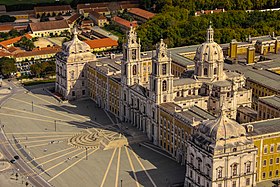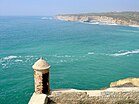Mafra | |
|---|---|
 | |
| Coordinates: 38°56′28″N 9°19′55″W / 38.94111°N 9.33194°W | |
| Country | |
| Region | Lisbon |
| Metropolitan area | Lisbon |
| District | Lisbon |
| Parishes | 11 |
| Government | |
| • President | Hugo Luís (PSD) |
| Area | |
| • Total | 291.66 km2 (112.61 sq mi) |
| Elevation | 115 m (377 ft) |
| Population (2011) | |
| • Total | 76,685 |
| • Density | 260/km2 (680/sq mi) |
| Time zone | UTC±00:00 (WET) |
| • Summer (DST) | UTC+01:00 (WEST) |
| Postal code | 2644 |
| Area code | 261 |
| Patron | Santo André |
| Website | www |
Mafra (Portuguese pronunciation: [ˈmafɾɐ] ) is a city and a municipality in the district of Lisbon, on the west coast of Portugal, and part of the urban agglomeration of the Greater Lisbon subregion. The population in 2011 was 76,685,[1] in an area of 291.66 km2.[2]
It is mostly known for the sumptuous Mafra National Palace inscribed as a UNESCO World Heritage Site.[3] Built in the baroque style, the Mafra National Palace also inspired Portuguese Nobel Prize laureate José Saramago to write his novel Baltasar and Blimunda (Memorial do Convento). Other points of interest around the municipality include the Tapada Nacional de Mafra (also part of the UNESCO site), an enclosed wildlife and game reserve, and Ericeira's World Surf Reserve, the second in the world.
- ^ Instituto Nacional de Estatística
- ^ "Áreas das freguesias, concelhos, distritos e país". Archived from the original on 2018-11-05. Retrieved 2018-11-05.
- ^ "Six cultural sites added to UNESCO's World Heritage List". UNESCO. 2019-07-07. Retrieved 2019-07-08.






